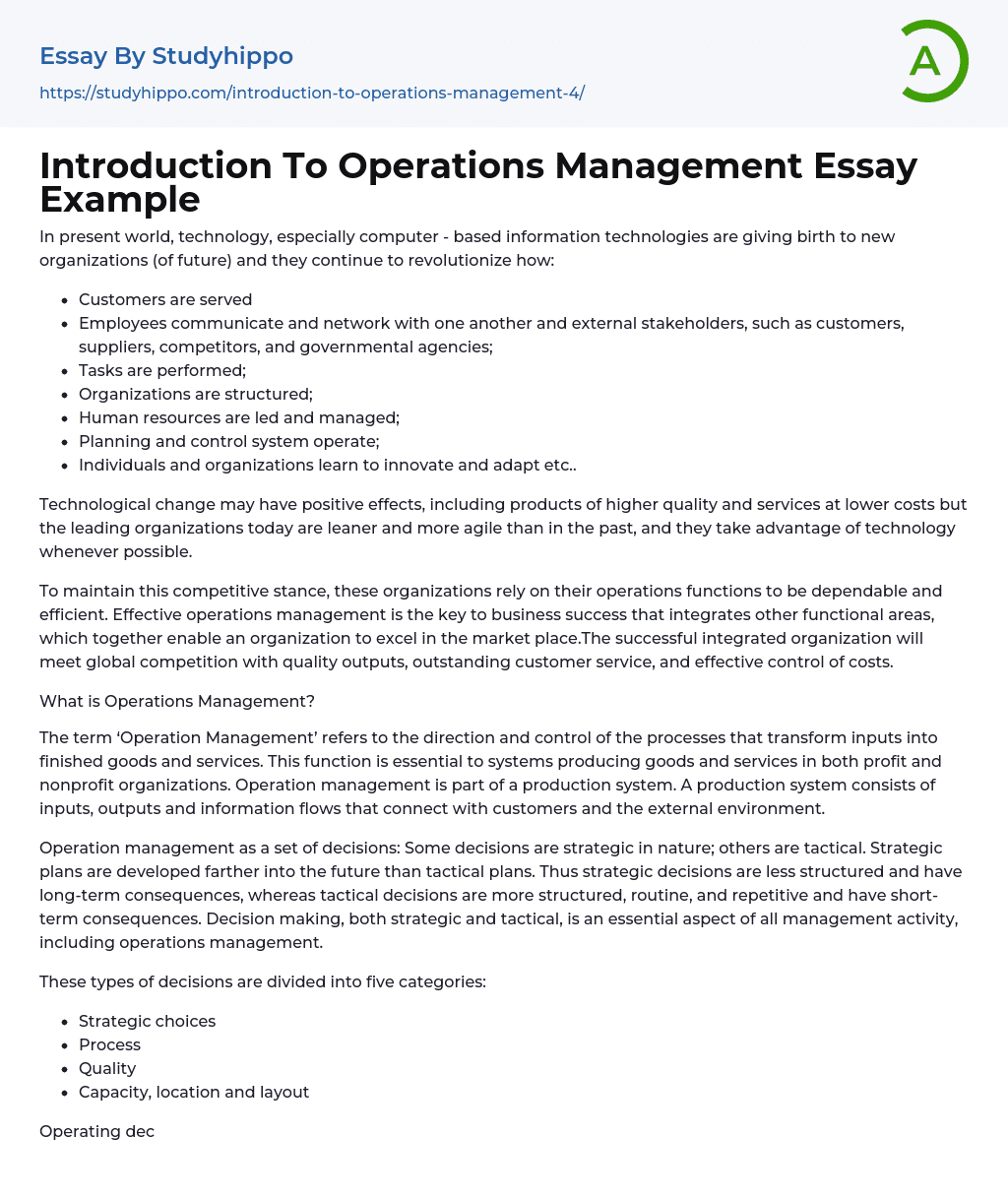Technology, especially computer-based information technologies, is currently giving rise to new organizations and revolutionizing various aspects of business. These include how customers are served, how employees communicate and network with stakeholders both within and outside the organization, how tasks are performed, the structure of organizations, leadership and management of human resources, operations planning and control systems, and fostering innovation and adaptation. While technological advancements can have positive effects such as improved product quality and lower costs, today's leading organizations prioritize agility and efficiency by leveraging technology whenever possible. These organizations rely on effective operations management to maintain their competitive stance. Operations management is the key to integrating different functional areas within an organization, enabling it to excel in the marketplace by delivering quality outputs, exceptional customer service, and cost control. In essence, operations manage
...ment encompasses the direction and control of processes that convert inputs into finished goods and services.
This function is crucial for both profit and nonprofit organizations in producing goods and services. Operation management is a component of a production system, which includes inputs, outputs, and information flows that interact with customers and the external environment. Operation management is comprised of various decisions, some of which are strategic and others are tactical. Strategic decisions have long-term consequences, are less structured, and are developed for future plans. On the other hand, tactical decisions have short-term consequences, are more structured and routine, and are made for immediate plans.
Decision making in management, including operations management, is crucial and can be divided into five categories: strategic choices, process, quality, capacity, location, and layout. In large organizations, the operations department is responsible for transforming inputs into finished products o
services. Accounting handles financial information, while distribution manages the movement and storage of inputs and outputs.
Engineering is in charge of product and service design and production methods. Finance focuses on capital asset securing and investment. Human resources, or personnel, hires and trains employees. Marketing generates demand for the company's output. It is important to note that not all organizations need all of these functions.
Other organizations may save money by contracting for a function, such as legal services or engineering, as needed, rather than maintaining an in-house department. In small businesses, the owners might manage one or more functions, such as marketing or operations, themselves.
III. Managing Change Change is inevitable and most project managers deal with more than their fair share of it on any project. Many tend to view change as problems or negative consequences.
Change can have both negative and positive consequences within an organization. When implementing change, there are four key factors for success:
- Pressure for change - senior management commitment is crucial.
- A clear, shared vision - involving everyone in the organization and having a common agenda that benefits all is necessary.
- Capacity for change - providing resources such as time and finance.
- Action and performance - following the "plan, do, check, act" approach and maintaining open communication channels are important.
Project managers need to consider three elements of change management. The first element involves determining the project manager's authority to approve or deny changes impacting the project. The second element requires establishing an environment that facilitates effective change
management by communicating expectations to the project team. Lastly, implementing a system for requesting and tracking changes allows for informed decision-making regardless of approval or denial.
Operations and strategy
Developing a customer-driven operations strategy starts with market analysis, which categorizes the firm’s customers, identifies their needs, and assesses competitors' strengths.
This analysis is done alongside an analysis of the external environment. After that, the firm formulates its corporate strategy, which outlines the organization’s overall goals.
Once the firm has determined its target customers, it must develop its competitive priorities. These priorities are the capabilities and strengths that the firm needs to possess in order to meet customer demand.
In essence, operations strategy connects long- and short-term operations decisions to the corporate strategy. Continuous cross-functional interaction is necessary in implementing operations strategy - as well as any other functional strategy.
The long-range business plan is a comprehensive strategy that outlines the necessary steps to succeed in global markets. World-class producers confidently invest in various aspects of their business thanks to their well-planned long-term approach. These investments include personnel training, market development, new product/service development, advanced production processes, and research and development. By making these investments, world-class producers can take advantage of the opportunities outlined in their business plans. Specifically, they prioritize several key factors:
- Speeding up the introduction of new products/services to the market
- Being recognized for high-quality production
- Achieving high labor productivity and low production costs
- Prioritizing customer needs and customization
- Maintaining minimal excess inventory
- Having a global mindset when it comes to marketing and sourcing supplies
- Embracing new technologies quickly and effectively
- Being open to strategic alliances and joint ventures for global growth opportunities
- Considering relevant social issues when establishing strategies.
+
- Board Of Directors essays
- Brand Management essays
- Business Ethics essays
- Business Management essays
- Change Management essays
- Comparative Analysis essays
- Decision Making essays
- Dispute Resolution essays
- Knowledge Management essays
- Leadership essays
- Leadership and Management essays
- Manager essays
- Operations Management essays
- Performance Management essays
- Product Management essays
- Project Management essays
- Quality Management essays
- Risk essays
- Risk Management essays
- Scientific Management essays
- Stress Management essays
- supply chain management essays
- Time Management essays
- Total Quality Management essays
- Business Analysis essays
- Business Plan essays
- Community Development essays
- Competition essays
- Effective Leadership essays
- Leadership Styles essays
- Mission Statement essays
- Negotiation essays
- Outsourcing essays
- Planning essays
- Public relations essays
- Reasoning essays
- Strategic Management essays
- Strategic Planning essays
- Swot Analysis essays




